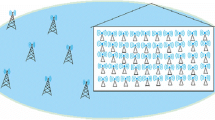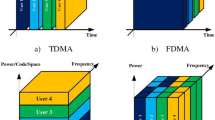Abstract
The opportunistic beamforming (OB) technique in multicellular OFDMA networks is investigated in this paper. Three cross-layer radio resource management (RRM) algorithms for OFDMA operational scenarios are considered. These algorithms build upon typical network planning practices for OFDMA systems. The first two implement an OFDMA network with opportunistic rate adaptation while the third one aims at a network which guarantees QoS provision through power control on carrier basis. The RRM algorithms are based on typical OFDMA resource allocation targets such as minimization of transmit power, maximization of throughput and interference averaging. Then, the OB concept is combined with the considered RRM algorithms and a comparative performance analysis between the two types of networks (omni and opportunistic beamforming) is performed in terms of throughput, blocking probability and fairness. The paper aims at providing a useful insight into the way the OB technique affects the performance of different OFDMA networks based on large scale simulations. The simulation results suggest that OB is preferred for OFDMA systems with opportunistic rate adaptation rather than power controlled systems which offer QoS provision. According to the presented results, OB provides to OFDMA systems with opportunistic rate adaptation a ∼13% throughput gain and ∼75% gain in terms of blocking probability. In addition, it is shown that the combination of OB with interference averaging RRM algorithms has a minor beneficial impact only on the system fairness.
Similar content being viewed by others
References
(2009). In IEEE standard for local and metropolitan area networks Part 16, Air interface for fixed broadband wireless access systems, IEEE Std. 802.16-2009.
Wong C. Y., Cheng R. S., Letaief K. B., Murch R. D. (1999) Multiuser OFDM with adaptive subcarrier, bit, and power allocation. IEEE Journal on Selected Areas in Communications 17(10): 1747–1758
Kivanc, D., & Liu, H. (2000). Subcarrier allocation and power control for OFDMA. In Proceedings of the 34th Asilomar Conference on Signals, Systems and Computers (ASILOMAR’00), November–December 2000 (pp. 147–151). Pacific Grove, CA.
Kivanc D., Li G., Liu H. (2003) Computationally efficient bandwidth allocation and power control for OFDMA. IEEE Transactions on Wireless Communications 2(6): 1150–1158
Pietrzyk, S., & Janssen, G. (2004). Radio resource allocation for cellular networks based on OFDMA with QoS guarantees. In Proceedings of IEEE Global Telecommunications Conference (GLOBECOM’04), November–December 2004 (pp. 2694–2699). Dallas, TX.
Stiakogiannakis, I., Zarbouti, D., Tsoulos, G., & Kaklamani, D. (2008). Subcarrier Allocation Algorithms for multicellular OFDMA networks without Channel State Information. In IEEE International Symposium on Wireless Pervasive Computing (ISWPC’08), May 2008 (pp. 73–77). Santorini, Greece.
Rhee, W., & Cioffi, J. M. (2000). Increase in capacity of multiuser OFDM system using dynamic subchannel allocation. In Proceedings of IEEE Vehicular Technology Conference (VTC’00), May 2000 (Vol. 2, pp. 1085–1089). Tokyo, Japan.
Jang J., Lee K. B. (2003) Transmit power adaptation for multiuser OFDM systems. IEEE Journal on Selected Areas in Communications 21(2): 171–178
Zhang Y. J., Letaief K. B. (2004) Multiuser adaptive subcarrier-and-bit allocation with adaptive cell selection for OFDM systems. IEEE Transactions on Wireless Communications 3(5): 1566–1575
Einhaus, M., Klein, O., & Lott, M. (2005). Interference averaging and avoidance in the downlink of an OFDMA system. In Proceedings of IEEE International Symposium on Personal, Indoor and Mobile Radio Communications (PIMRC’05), September 2005 (pp. 905–910). Berlin, Germany.
Zarbouti, D., Stiakogiannakis, I., Tsoulos, G., Athanasiadou, G., & Kaklamani, D. (2008). OFDMA techniques in multicellular networks with total frequency reuse. Computer Communications (Elsevier) September 2008. doi:10.1016/j.comcom.2008.09.011.
Viswanath P., Tse D. N. C., Laroia R. (2002) Opportunistic beamforming using dumb antennas. IEEE Transactions on Information Theory 48(6): 1277–1294
Scedman P., Wilson S. K., Cimini L. J., Ottersten B. (2007) Opportunistic beamforming and scheduling for OFDMA systems. IEEE Transactions on Communications 55(5): 941–952
Li G., Liu H. (2005) On the optimality of the OFDMA network. IEEE Communications Letters 9(5): 438–440
Cioffi, J. M. (1991). A multicarrier primer. Amati Communications Corporation and Stanford University, Technical Report T1E1.4/91-157, November
Goldsmith A. J., Varaiya P. P. (1997) Capacity of fading channels with channel side information. IEEE Transactions on Information Theory 43(6): 1986–1992
Kulkarni G., Adlakha S., Srivastava M. (2005) Subcarrier allocation and bit loading algorithms for OFDMA-based wireless networks. IEEE Transactions on Mobile Computing 4(6): 652–662
Athanaileas T. E., Gkonis P. K., Athanasiadou G. E., Tsoulos G. V., Kaklamani D. I. (2008) Implementation and evaluation of a web-based grid-enabled environment for WCDMA multibeam system simulations [wireless corner]. IEEE Antennas Propagation Magazine 50: 195–204
Athanasiadou, G., Wassell, I., & Hong, C. (2004). Deterministic propagation modelling and measurements for the broadband fixed wireless access channel. In Proceedings of IEEE Vehicular Technology Conference (VTC’04-Fall), September 2004 (pp. 76–80). Los Angeles, CA.
Athanasiadou, G. E. (2007). Incorporating the Fresnel zone theory in Ray tracing for propagation modelling of fixed wireless access channels. In Proceedings of IEEE International Symposium on Personal, Indoor and Mobile Radio Communications (PIMRC’07), September 2007 (pp. 1–5). Athens, Greece.
Athanasiadou G., Wassell I. (2005) Comparisons of Ray tracing predictions and field trial results for broadband fixed wireless access scenarios. WSEAS Transactions on Communications 4: 717–721
Sadr, S., Anpalagan, A., & Raahemifar, K. (2007). A Novel Subcarrier Allocation Algorithm for Multiuser OFDM System With Fairness: User’s Perspective. In Proceedings of IEEE Vehicular Technology Conference (VTC’07), September 2007 (pp. 1772–1776). Baltimore, USA
Author information
Authors and Affiliations
Corresponding author
Rights and permissions
About this article
Cite this article
Zarbouti, D.A., Tsilimantos, D.C., Tsoulos, G.V. et al. Performance of OFDMA Multicell Systems with Opportunistic Beamforming. Wireless Pers Commun 65, 843–861 (2012). https://doi.org/10.1007/s11277-011-0315-6
Published:
Issue Date:
DOI: https://doi.org/10.1007/s11277-011-0315-6




